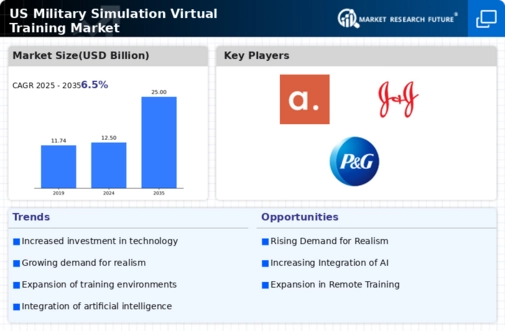The military simulation virtual training market is characterized by a dynamic competitive landscape, driven by technological advancements and the increasing demand for realistic training environments. Key players such as Lockheed Martin (US), Northrop Grumman (US), and Raytheon Technologies (US) are at the forefront, each adopting distinct strategies to enhance their market positioning. Lockheed Martin (US) emphasizes innovation through the integration of artificial intelligence (AI) and machine learning into its training systems, aiming to provide more adaptive and personalized training experiences. Northrop Grumman (US) focuses on strategic partnerships and collaborations to expand its capabilities, particularly in joint training exercises with allied nations. Meanwhile, Raytheon Technologies (US) is investing heavily in digital transformation initiatives, enhancing its simulation technologies to meet the evolving needs of military training.
The market structure appears moderately fragmented, with a mix of established players and emerging companies vying for market share. Key business tactics include localizing manufacturing to reduce costs and optimize supply chains, which is particularly relevant given the geopolitical landscape. The collective influence of these major players shapes the competitive environment, as they leverage their technological expertise and resources to maintain a competitive edge.
In November 2025, Lockheed Martin (US) announced a partnership with a leading technology firm to develop next-generation virtual training systems that utilize AI-driven analytics. This strategic move is likely to enhance the realism and effectiveness of training programs, positioning Lockheed Martin (US) as a leader in innovative training solutions. The collaboration underscores the importance of integrating cutting-edge technology into military training, potentially setting new standards in the industry.
In October 2025, Northrop Grumman (US) secured a contract with the U.S. Army to provide advanced simulation training systems for joint operations. This contract not only reinforces Northrop Grumman's (US) commitment to supporting military readiness but also highlights its strategic focus on enhancing interoperability among allied forces. Such initiatives are crucial as they align with the increasing emphasis on joint training exercises in modern military operations.
In September 2025, Raytheon Technologies (US) launched a new virtual training platform designed to simulate complex battlefield scenarios. This platform incorporates real-time data analytics and feedback mechanisms, allowing for a more immersive training experience. The introduction of this technology reflects Raytheon Technologies' (US) proactive approach to meeting the demands of contemporary military training, emphasizing the need for adaptability and responsiveness in training methodologies.
As of December 2025, current trends in the military simulation virtual training market are heavily influenced by digitalization, sustainability, and AI integration. Strategic alliances among key players are shaping the landscape, fostering innovation and enhancing capabilities. The competitive differentiation is likely to evolve from traditional price-based competition to a focus on technological innovation, reliability in supply chains, and the ability to deliver customized training solutions. This shift indicates a future where the emphasis will be on creating value through advanced technologies and strategic partnerships.














Leave a Comment